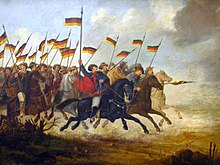Farrapen Revolution

The Farrapen Revolution (Portuguese: Guerra dos Farrapos or Revolução Farroupilha , literally: war of the ragged ) was a war between insurgents of the then southern Brazilian province of São Pedro do Rio Grande do Sul and the Empire of Brazil ; it lasted from September 19, 1835 to March 1, 1845.
causes
Originally, the revolt was based on the political struggle between the Liberals, who proposed a state model with more autonomy for the provinces, and the supporters of the 1824 Constitution, with its more centralized approach. There were also economic differences between Rio Grande do Sul and the rest of Brazil. The province's main product was charque , salted dried meat that was subject to high internal tariffs , while charque from Uruguay and Argentina could be imported duty-free.
course
The brief republican uprising of 1830 was directed against the politics of the empire and was a forerunner of the Farrapen revolution. João Manoel de Lima e Silva , the commander of the 28th Jäger Battalion, wanted to proclaim the Republic and Samuel Gottfried Kerst as its president with the participation of German soldiers, including Otto Heise (1801-1837) .
On September 20, 1835, Bento Gonçalves da Silva conquered the capital Porto Alegre and started a second uprising against the trade policy of the central government, which was perceived as unjust. The president of Rio Grande do Suls, Antonio Rodrigues Braga , fled to the southern Rio Grande , while the rebels elected Marciano Pereira Ribeiro as their new president. The regent Diogo Feijó appointed a new president who had to take office in Rio Grande. General Antônio de Sousa Neto declared the independence of Rio Grande do Sul as the Republic of Piratini on September 11, 1836 with Gonçalves da Silva as the nominated president. Gonçalves da Silva was captured by imperial forces but managed to escape in 1837. On May 15, 1836, Porto Alegre fell back into the hands of the central government and could not be recaptured by the rebels.
In 1839 Giuseppe Garibaldi - he was supposed to get to know his wife Anita - joined the separatists, and the uprising spread to the northern province of Santa Catarina , whose capital was Laguna , and the short-lived Republic of Juliana (July 29 to November 15, 1839) was called out. Laguna fell back into the hands of the central government just four months later. In 1842 the separatists passed a liberal constitution. In the same year, Luís Alves de Lima e Silva was appointed president of Rio Grande do Suls and commander in chief of the troops tasked with suppressing the uprising. He managed to find a negotiated solution.
The End
On March 1, 1845, both parties signed the Treaty of Poncho Verde in Poncho Verde (also known as "Ponche Verde"), now a district of Dom Pedrito . In it, the separatists were promised an amnesty , acceptance into the Brazilian imperial army , repayment of the debts of the Republic of Piratini and a 25 percent duty on imported charque.
literature
- Samuel Gottfried Kerst . About the Brazilian conditions of the present, with reference to the German emigration to Brazil and the system of the Brazilian planters to replace the lack of African slaves with German proletarians, at the same time to clear the writing of the Kaiserl. brasil. Prof. Dr. Gade: Report on the German colonies on the Rio Preto . Berlin: Veit & Comp. 1853. 97 S. Can be read online at digital texts of the library of the seminar for economic and social history of the University of Cologne: http://www.digitalis.uni-koeln.de/Kerst/kerst_index.html
- Ivar Hartmann. Aspectos da Guerra dos Farrapos . Editora Feevale. 2002. Novo Hamburgo. ISBN 85-86661-24-4 . Online, as pdf: [1] (Accessed December 11, 2014)
Web links
- David X. Noack: Garibaldi's fight for the Republic of Rio Grande do Sul amerika21.de of September 22, 2012
Footnotes
- ^ Nilton Freixinho: International Relations in South America Nineteenth Century. A Case Study: The Independence and Sovereignty of Uruguay . In: Maintien de la paix de 1815 à aujourd'hui. Actes du XXIe colloque de la Commission Internationale d'Histoire Militaire . Department of National Defense, Ottawa 1995, ISBN 0-662-62062-3 , pp. 612-619, here p. 617.

